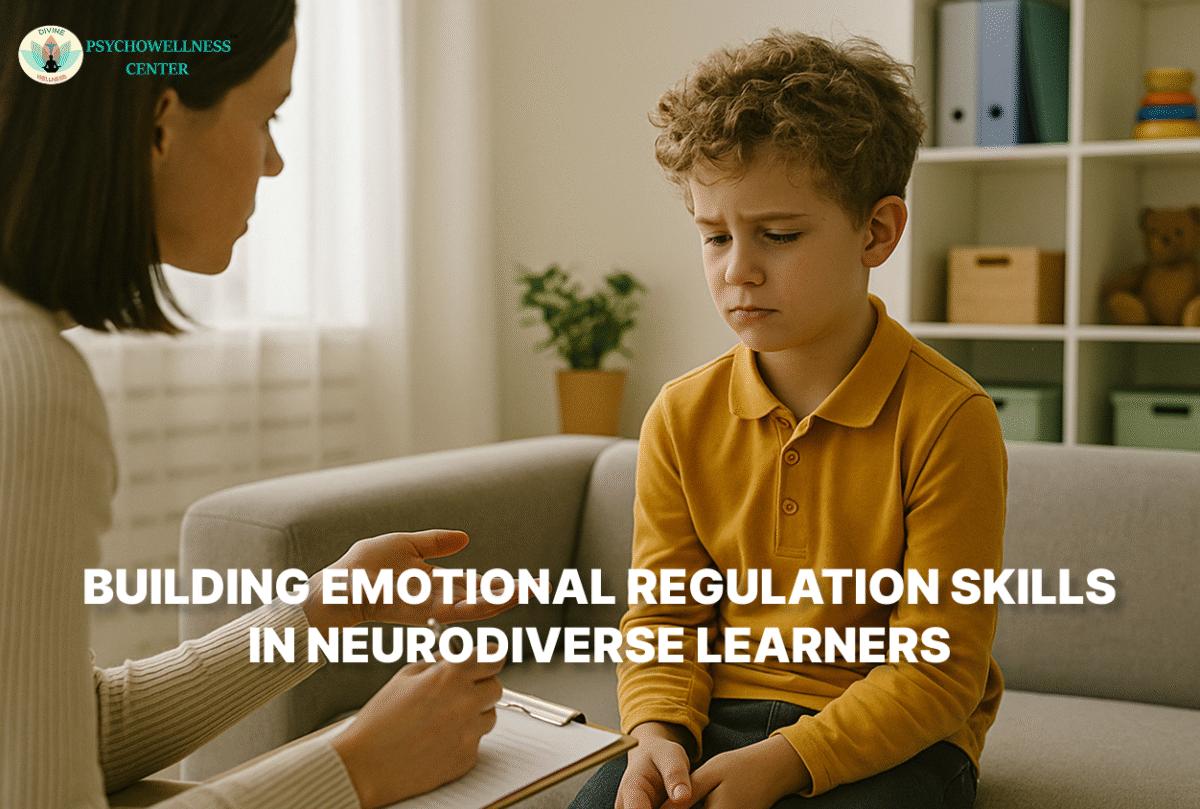Emotional regulation—the capacity to recognise, manage, and respond appropriately to emotions—is foundational for healthy development. For neurodiverse youth, including those with autism spectrum disorder (ASD), ADHD, or other neurological differences, emotional regulation can be especially challenging. These learners often experience heightened sensory sensitivities, differences in executive functioning, and difficulty with emotional awareness (alexithymia), all of which may interfere with their ability to regulate emotions effectively.
- Understand Their Unique Needs
Many neurodiverse learners use maladaptive coping strategies—like avoidance, rigidity, or emotional suppression—due to challenges in processing emotions. These behaviours often stem from limited self-regulation skills, not a lack of willingness to engage. Programs like the 16-week Emotional Awareness and Skills Enhancement (EASE) therapy for autistic adolescents have shown measurable gains in emotional awareness and reduced behavioural issues, underscoring the value of tailored, research-based approaches.
2. Create Predictable, Sensory-Friendly Environments
Environmental predictability helps reduce anxiety in neurodiverse learners by offering consistent routines, clear expectations, and sensory supports. Tools like visual schedules, first-then boards, and countdown timers help ease transitions, while calm corners equipped with items such as noise-cancelling headphones, weighted blankets, and fidget tools provide a safe space for self-regulation.
3. Build Emotional Awareness and Vocabulary
Around 50% of autistic individuals experience alexithymia, making it hard to identify and express emotions. Building emotional literacy—linking body sensations to feelings—is key to emotion control. Tools like emotion charts, feeling flashcards, and body-mapping activities support this, while expanding vocabulary to include nuanced terms (e.g., anxious, frustrated) helps learners better understand and express their emotions.
4. Teach Concrete Regulation Strategies
Emotional regulation must be explicitly taught using evidence-based tools. Techniques that have proven effective include:
- Mindfulness and Breathing Techniques: Programs like EASE have shown that even brief daily mindfulness or breathing practices can significantly reduce emotional reactivity.
- Progressive Muscle Relaxation and Body Scans: These practices improve interoception, the awareness of internal body cues related to stress and emotion.
- Coping Kits: Personal toolkits containing fidget toys, stress balls, headphones, or visual timers give learners tangible strategies for self-soothing.
- Role-Playing and I-Statements: Structured social practice with guided support helps learners articulate feelings and responses appropriately.
5. Use Visual Supports and Social Narratives
Visual supports are highly effective for neurodiverse learners. The Zones of Regulation, a colour-coded tool, helps students identify emotions and choose regulation strategies, with adaptations available for AAC users. Social stories—personalised, first-person narratives—prepare students for challenging situations and teach expected responses, making them useful across age groups.
6. Incorporate Regular Emotional Check-Ins
Routine emotional reflection reinforces regulation skills. Techniques like emotion journals, daily feelings boards, or rose-thorn-bud sharing (something good, something hard, something to look forward to) foster daily emotional processing. These check-ins help educators and caregivers identify emotional triggers early and support ongoing emotional development.
7. Model Calm, Empathy, and Co-Regulation
Adults are key role models for emotional regulation. When caregivers and educators model emotional management. Co-regulation, the process by which an adult helps a child manage emotional distress through shared calming activities, is also vital. Providing physical comfort, using reassuring language, and staying present in a moment of distress lays the foundation for self-regulation.
8. Encourage Physical Movement and Healthy Sleep
Emotional control is directly related to both physical exercise and restful sleep. Regular movement breaks, such as walking, stretching, dancing, or yoga, help release stress and reset focus. Good sleep hygiene—regular routines, low-stimulation environments before bed—supports brain processes essential for managing emotions. Conversely, sleep deprivation can worsen irritability, impulsivity, and mood swings.
9. Embed Skills Across Settings
For emotional regulation strategies to become internalised, they must be practised across multiple settings—home, school, therapy, and community. Extending visual tools, sensory supports, and routines into each of these contexts builds consistency. Technologies such as emotion-tracking apps, virtual reality (VR) social scenarios, and socially assistive robots offer engaging and personalised practice tools for learners who may benefit from digital interaction.
10. Reinforce Progress and Respect Neurodiversity
Reinforcement is key. Keep track of progress with diaries or charts to tailor strategies and celebrate growth, even in small steps. Lastly, it is essential to respect neurodiverse coping behaviours. Stimming (repetitive behaviours) is not a problem to be solved; for many autistic people, it is a tool for self-regulation. Suppressing these behaviours may increase anxiety or emotional distress.
Conclusion
Emotional regulation is not a one-time lesson but a long-term process nurtured through understanding, structure, and empathy. For neurodiverse learners, success in regulating emotions depends on supportive environments, explicit instruction, consistent routines, sensory accommodations, and adult modelling. When emotional skills are embedded in everyday experiences—and when we respect each learner’s natural regulatory styles—we create the foundation for:
- Confident social engagement
- Learning with reduced emotional overload
- Healthy emotional expression
By investing in these supports, we empower neurodiverse learners to thrive both in the classroom and beyond, with tools that last a lifetime. If you’ve been searching for the “best psychologist near me” to support a neurodiverse child or student in developing emotional regulation skills, help is closer than you think. The experienced therapists at Psychowellness Center in Janakpuri and Dwarka Sector-17, Delhi, specialise in neurodevelopmental care. Prefer therapy from home? TalktoAngel offers safe and confidential online sessions with leading psychologists across India. Call 011-47039812 or 7827208707 immediately to start on the road to emotional growth and balance.
Contributions by Dr. R. K. Suri and Ms. Chanchal Agarwal reflect their experience as a clinical psychologist and counselling psychologist. Sessions can be booked for personalized support.
References
- EASE. (n.d.). Mindfulness-based intervention for autism [Clinical trial registration]. ClinicalTrials.gov. https://clinicaltrials.gov
- Zones of Regulation. (n.d.). A curriculum to foster self-regulation and emotional control. https://zonesofregulation.com
- Karkhaneh, M., Clark, B., Ospina, M. B., Seida, J. C., Smith, V., & Hartling, L. (2010). Social Stories™ to improve social skills in children with autism spectrum disorder: A systematic review. Autism, 14(6), 641–662. https://doi.org/10.1177/1362361310373057
- Gulsrud, A. C., Jahromi, L. B., & Kasari, C. (2009). The co-regulation of emotions between mothers and their children with autism. Journal of Autism and Developmental Disorders, 40(2), 227–237. https://doi.org/10.1007/s10803-009-0861-x
- https://www.psychowellnesscenter.com/Blog/significance-of-emotional-regulation-in-daily-life/

